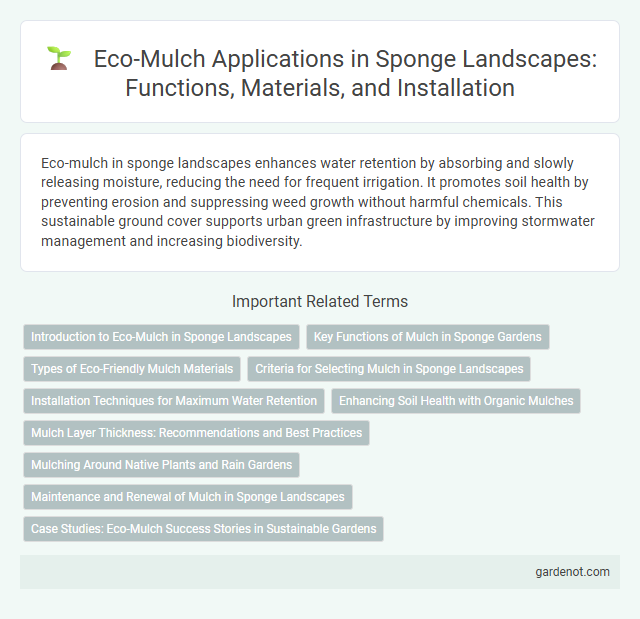Eco-mulch in sponge landscapes enhances water retention by absorbing and slowly releasing moisture, reducing the need for frequent irrigation. It promotes soil health by preventing erosion and suppressing weed growth without harmful chemicals. This sustainable ground cover supports urban green infrastructure by improving stormwater management and increasing biodiversity.
Introduction to Eco-Mulch in Sponge Landscapes
Eco-mulch in sponge landscapes enhances water retention and reduces soil erosion by creating a protective organic layer over the soil surface. It supports sponge landscape goals by improving soil permeability and promoting groundwater recharge during heavy rainfall. Utilizing biodegradable materials for eco-mulch aligns with sustainable urban drainage systems (SUDS) to mitigate urban flooding and maintain ecosystem health.
Key Functions of Mulch in Sponge Gardens
Eco-mulch in sponge gardens significantly enhances water retention by reducing soil evaporation and promoting infiltration. It stabilizes soil temperature, preventing heat stress to plants and microorganisms essential for the sponge function. Furthermore, eco-mulch suppresses weed growth, minimizing competition for nutrients and improving overall garden health and resilience.
Types of Eco-Friendly Mulch Materials
Eco-mulch includes biodegradable options such as shredded leaves, straw, and wood chips, which enhance soil moisture retention and nutrient cycling. Organic materials like cocoa hulls and pine needles improve soil structure while suppressing weed growth naturally. Inorganic eco-friendly alternatives include rubber mulch from recycled tires and coconut coir, providing durability without harming the environment.
Criteria for Selecting Mulch in Sponge Landscapes
Effective eco-mulch selection in sponge landscapes prioritizes permeability, organic composition, and moisture retention capacity to enhance soil infiltration and reduce runoff. The mulch must be biodegradable and sourced sustainably to support soil microbial activity while minimizing environmental impact. Particle size and texture are crucial for optimizing water absorption and facilitating vegetation growth within permeable urban infrastructure.
Installation Techniques for Maximum Water Retention
Eco-mulch installation techniques focus on evenly spreading a 2-4 inch layer of organic materials such as wood chips or shredded bark around plants to reduce soil evaporation and improve water infiltration. Applying mulch directly on sponge landscape contours enhances absorption and prevents surface runoff by allowing rainwater to percolate through porous layers. Maintaining consistent mulch thickness and avoiding compaction ensures maximum water retention and supports healthy root development in sponge landscape systems.
Enhancing Soil Health with Organic Mulches
Eco-mulch improves soil health by increasing moisture retention, reducing erosion, and promoting beneficial microbial activity in sponge landscapes. Organic mulches such as wood chips, straw, and compost enrich soil nutrients while enhancing aeration and temperature regulation. These natural materials support sustainable landscaping by fostering a resilient and fertile growing environment.
Mulch Layer Thickness: Recommendations and Best Practices
Mulch layer thickness directly influences water retention, soil temperature regulation, and weed suppression in sponge landscape designs. Experts recommend maintaining a mulch thickness of 2 to 4 inches to optimize moisture conservation while preventing root suffocation and fungal growth. Applying mulch uniformly and avoiding excessive layers enhances soil aeration and supports healthy plant development.
Mulching Around Native Plants and Rain Gardens
Eco-mulch provides essential moisture retention and temperature regulation when applied around native plants and rain gardens, promoting healthier root systems and reducing water runoff. This organic layer supports soil biodiversity by enhancing microbial activity and nutrient cycling, crucial for sustaining the native ecosystem. Proper mulching with eco-friendly materials helps prevent erosion while improving infiltration in rain gardens, ensuring effective stormwater management.
Maintenance and Renewal of Mulch in Sponge Landscapes
Eco-mulch in sponge landscapes significantly enhances soil moisture retention and reduces erosion by creating a protective organic layer. Regular maintenance involves replenishing mulch layers annually to sustain permeability and nutrient cycling, ensuring optimal absorption of rainwater. Renewal practices include removing decomposed mulch and integrating fresh organic material to maintain soil structure and promote vegetation health, crucial for effective stormwater management.
Case Studies: Eco-Mulch Success Stories in Sustainable Gardens
Eco-Mulch has demonstrated significant success in sustainable gardens by improving soil moisture retention and reducing weed growth, as shown in case studies from community gardens in California and urban farms in New York. These projects reported up to a 40% decrease in water use and enhanced plant health, validating Eco-Mulch's effectiveness in promoting eco-friendly landscaping practices. Data from these studies emphasize the mulch's ability to support biodiversity and soil regeneration, making it a valuable asset for sustainable garden management.
Eco-mulch Infographic

 gardenot.com
gardenot.com